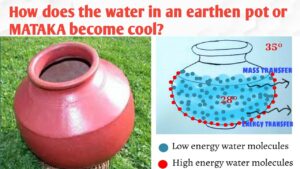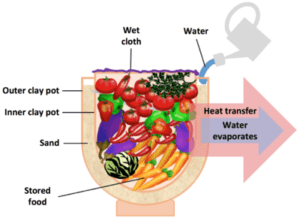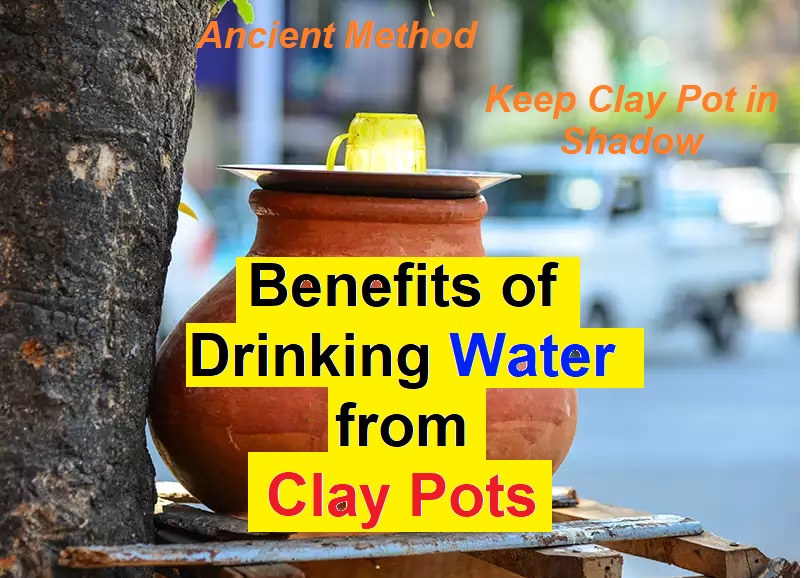- Clay pots are an ancient and simple yet effective way of cooling water in hot and arid regions
- They are commonly used in areas where electricity or refrigeration is not available or too expensive to use
- The process of cooling water in a mud pot involves a combination of evaporative cooling and conduction.

Evaporative Cooling
- Evaporative cooling is a process in which water evaporates from the surface, which absorbs heat from the surroundings and cools the surface
- The walls of a mud pot are porous and made of clay, which allows the water to seep through and evaporate from the surface. As the water evaporates, it removes heat from the surrounding area and cools down the water in the pot.
- The process of conduction also plays a significant role in cooling the water in a mud pot.
- The clay used to make mud pots is an excellent conductor of heat. When the pot is filled with water, the water molecules come in contact with the clay surface, which conducts heat away from the water and into the surrounding environment. This heat transfer process further cools the water in the pot.
- The shape and size of the mud pot also play a crucial role in the cooling process. The wide and shallow shape of the pot increases the surface area of the water exposed to the air, which enhances the evaporative cooling process.
- The small opening at the top of the pot reduces the amount of air entering the pot, which reduces the rate of evaporation, and keeps the water cool for a more extended period.

- In addition to being an efficient way of cooling water, mud pots are also eco-friendly and sustainable. They do not require any electricity or other energy sources, and they are made from locally available and renewable resources. Mud pots are also easy to maintain and clean, and they can be reused for an extended period.
Health Benefits Drinking Water from an Earthen Pot
- Drinking water from an earthen pot has numerous health benefits. It is a natural and eco-friendly way to store and consume water
- By using an earthen pot to store water, you can enjoy cool, mineral-rich, and alkaline water that is healthy and refreshing. So, switch to an earthen pot to store your drinking water and enjoy the benefits it has to offer.
- Drinking water is essential for good health. However, the way we consume water can also have an impact on our health. One traditional method of storing water is in an earthen pot. Here are some of the benefits of drinking water from an earthen pot.
Natural Cooling
- One of the most significant benefits of storing water in an earthen pot is its natural cooling properties
- The porous nature of the clay allows water to seep through, and when the water evaporates, it cools the pot and the water within it. Drinking cool water can help regulate body temperature and prevent dehydration.

Alkaline Water:
- Water stored in an earthen pot is naturally alkaline
- The pH level of alkaline water is higher than regular tap water, which can help neutralize the acid in the body
- Drinking alkaline water can help improve digestion, reduce inflammation, and boost the immune system.
Mineral-rich water:
- Earthen pots are made from natural clay, which is a rich source of minerals such as calcium, magnesium, and potassium
- When water is stored in an earthen pot, it absorbs these minerals, making the water healthier to drink.
- These minerals are essential for maintaining good health and can help improve bone density, muscle function, and heart health.
Safe and eco-friendly:
- Drinking water from an earthen pot is safe and eco-friendly. Unlike plastic bottles, which can leach harmful chemicals into the water, earthen pots are made from natural materials and do not contain any harmful chemicals. Additionally, using an earthen pot to store water is a sustainable option, as it does not contribute to plastic waste.
Enhanced Taste
- Water stored in an earthen pot has a unique taste that many people find refreshing
- The earthy flavor of the water is due to the minerals and nutrients that are absorbed from the clay. Drinking water from an earthen pot can be a pleasant and refreshing experience.
Low cost and economy
- Low cost for water cooling compared to the freeze water
Types of earthen pots
There are several types of earthen pots for water, each with its own unique characteristics and uses:
Matka:
- This is a traditional Indian earthen pot, which is small in size and has a narrow neck. It is used to store and cool water.
Surahi:
- This is a tall and slender earthen pot with a small mouth, which is commonly used in Indian households to store drinking water. It is believed to keep the water cool and also enhance its taste.
Handi:
- This is a larger earthen pot with a wide mouth, which is commonly used to store water for cooking purposes. It is also used for making curries and other dishes.
Kalash:
- This is a decorative earthen pot, which is used for religious purposes in Hindu rituals. It is usually decorated with intricate designs and is filled with holy water.
Amphora:
- This is a type of earthen pot used in ancient Greece and Rome for storing and transporting water and wine. It has a narrow neck and two handles on the sides for easy carrying.
Olla:
- This is a large, rounded earthen pot with a wide mouth, which is commonly used in Mexican cuisine for cooking beans, stews, and other dishes
- It is also used to store water.
Earthen pots are preferred for storing water as they are porous and help to keep the water cool by allowing it to evaporate through the walls. They also add a natural flavor to the water, which is believed to have health benefits.
Summary
- Mud or clay pots are a simple yet effective way of cooling water in hot and arid regions
- The combination of evaporative cooling and conduction, along with the shape and size of the pot, makes it an efficient and eco-friendly way of keeping water cool
- As the world is moving towards sustainable and environmentally friendly practices, mud pots offer a simple solution to cool water without relying on electricity or other energy sources.


